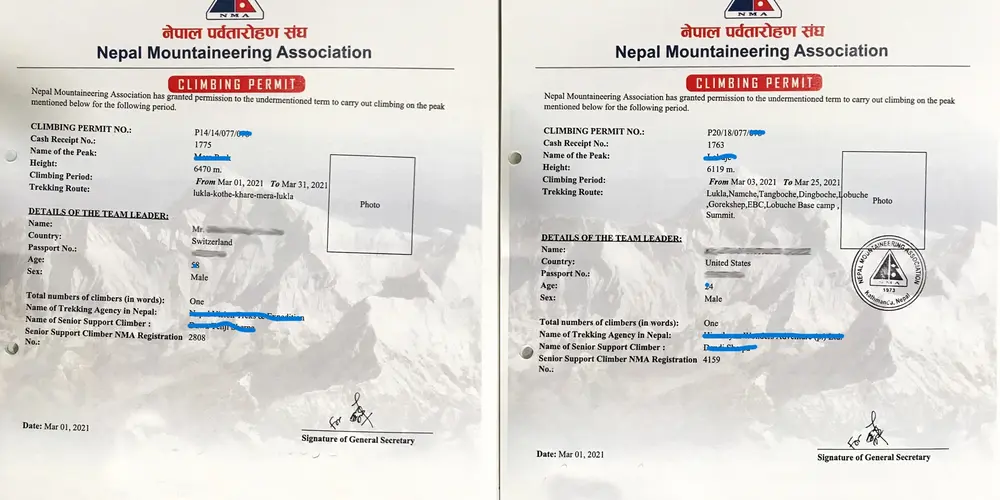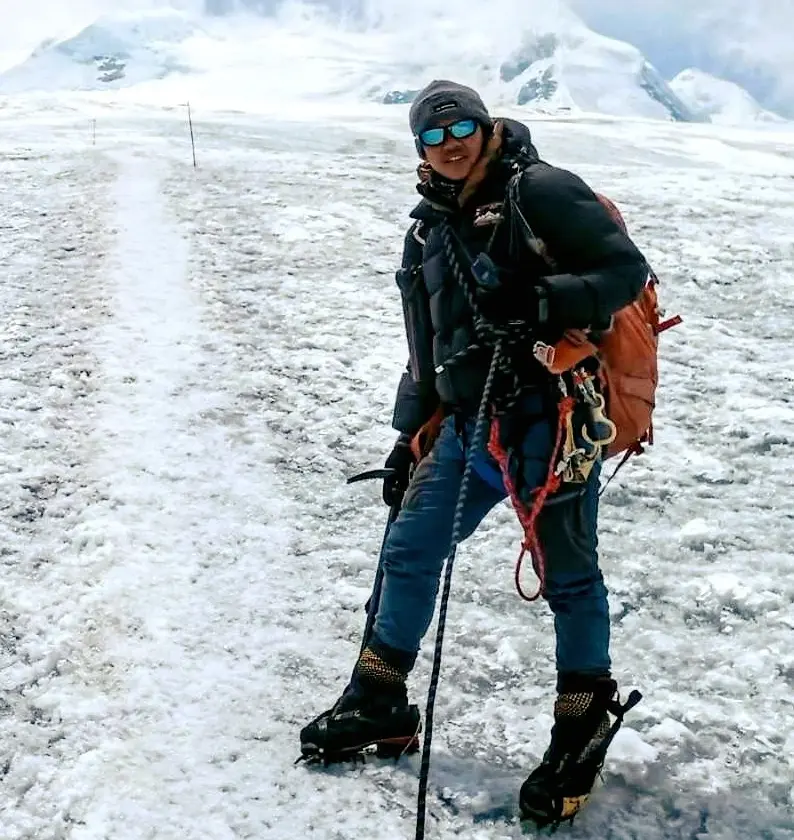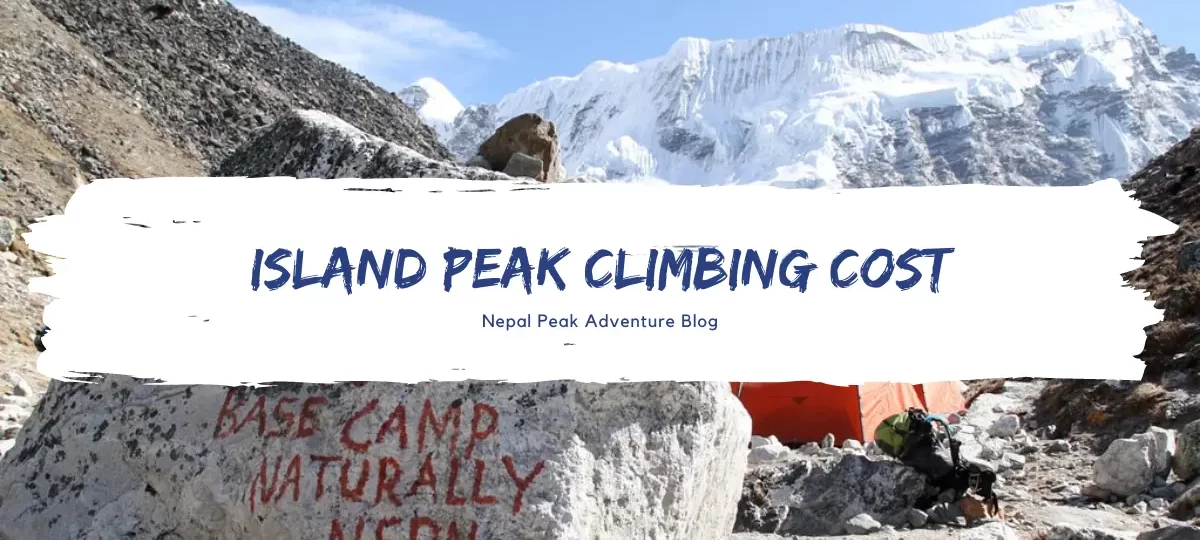Island Peak Climbing Cost: Cost Breakdown
Island Peak, also known as Imja Tse, is a popular climbing destination in the Everest region of Nepal. Standing at an elevation of 6,189 meters (20,305 feet), it offers an exhilarating and challenging climbing experience.
This majestic peak is situated in the heart of the Khumbu Valley, surrounded by breathtaking views of towering Himalayan peaks, including Lhotse, Nuptse, and Ama Dablam.
Island Peak climbing is a thrilling adventure that attracts mountaineers from around the world. The journey begins with a scenic flight from Kathmandu to Lukla, followed by a trek through picturesque Sherpa villages, lush forests, and high-altitude landscapes. The climb itself requires technical skills, including the use of crampons, ropes, and ice axes, making it suitable for experienced climbers or those with proper training.
Table of Contents
Importance of knowing the Island Peak Climbing Cost:
Understanding the Island Peak climbing cost is crucial for anyone planning to embark on this adventure. It helps in budgeting and ensures that climbers are adequately prepared for the financial aspects of the expedition. By knowing the costs involved, climbers can plan their finances, make informed decisions, and have a smooth experience without any unexpected financial setbacks during their climb.
The Island Peak climbing cost includes various components that climbers should consider. Island Peak Climbing permit fees are an essential aspect, as climbers need to obtain permits from the Nepal Mountaineering Association (NMA) and the Sagarmatha National Park. These permits contribute to the preservation and management of the region’s natural resources and help support local communities.
Travel expenses are another factor to consider. These may include domestic flights to Lukla, transportation to the starting point of the trek, and accommodation in Kathmandu or other transit points. Accommodation and meals during the trek are also part of the cost, as climbers typically stay in tea houses or lodges along the route.
Equipment and gear play a significant role in the overall cost. Climbers may choose to rent or purchase climbing equipment such as ice axes, crampons, harnesses, helmets, and sleeping bags. Additionally, hiring experienced guides and porters is advisable, both for safety and convenience and their fees contribute to the overall cost.
Insurance and rescue costs are vital considerations to ensure climbers’ safety. It is crucial to have adequate travel insurance that covers high-altitude climbing and emergency evacuation in case of any unforeseen circumstances. These expenses contribute to peace of mind and provide necessary support in case of emergencies.
Factors Affecting the Island Peak Climbing Cost
To make it more informative, here are the factors affecting the Island peak climbing cost. Understanding these factors will help climbers make informed decisions and budget accordingly. Here are the key elements that contribute to the Island Peak climbing cost:
Permit Fees and Regulations
Before embarking on the Island Peak climb, climbers must obtain the necessary permits. These include permits from the Nepal Mountaineering Association (NMA) and the Sagarmatha National Park.
The permit fees are determined by the government and are subject to change. It is essential to check the latest permit requirements and fees to ensure compliance with regulations. These fees contribute to the preservation and management of the region’s natural resources and support local communities.
Travel Expenses
Travel expenses are a significant part of the Island Peak climbing cost. The journey usually begins with a flight from Kathmandu to Lukla or Ramechhap to Lukla, a small town in the Everest region.
Domestic flight tickets to Lukla can vary depending on the season and availability. It’s advisable to consider these costs while planning the budget for the climb.
Accommodation and Meals
During the Island Peak climbing expedition, climbers stay in tea houses or lodges along the trekking route. The cost of accommodation and meals can vary depending on the location and the facilities provided.
In more remote areas, the availability of basic amenities may be limited, and the costs can be slightly higher. It’s important to factor in these expenses for the duration of the climb, as climbers require proper rest and nourishment during their journey.
Equipment and Gear
Climbing Island Peak requires specialized equipment and gear to ensure safety and success. Depending on personal preference, climbers can choose to rent or purchase their climbing equipment.
Essential items include ice axes, crampons, harnesses, helmets, sleeping bags, and appropriate clothing for high-altitude conditions. The cost of renting or buying this equipment can significantly impact the overall climbing cost. It’s crucial to invest in quality gear and ensure that it meets the necessary safety standards.
Guide and Porter Costs
Hiring experienced guides and porters is highly recommended for a safe and well-organized climb. Guides provide valuable expertise, knowledge of the route, and assistance in navigating challenging terrain. Porters help carry the heavy load, allowing climbers to focus on the climb itself. The fees for guides and porters vary based on their experience and the duration of the expedition. Including these costs in the budget ensures a smoother and more enjoyable climbing experience.
Insurance and Rescue Costs
Having comprehensive travel insurance is essential for Island Peak climbing. Insurance should cover high-altitude mountaineering activities and emergency medical evacuation if needed. The cost of insurance depends on factors such as coverage limits, duration, and the insurer’s terms and conditions. It’s crucial to carefully review insurance policies to ensure they meet the specific requirements of climbing Island Peak. Including insurance costs in the budget provides peace of mind and financial protection in case of any unforeseen circumstances.
Island Peak Climbing Cost Breakdown
To have a clear understanding of the overall cost involved in climbing Island Peak, it’s helpful to break down the expenses into specific categories. Here is a breakdown of the Island Peak climbing cost:
Permit Fees

Permit fees are a crucial component of the Island Peak climbing cost. Climbers are required to obtain permits from the Nepal Mountaineering Association (NMA) and the Sagarmatha National Park. The permit fees are set by the government and are subject to change.
During the month of Spring, the climbing permit costs USD 250 per climber, and during the Autumn season, it is USD 125. As for the off-seasons like Monsoon and winter, it is only USD 70 per person for the climbing permit.
It’s essential to check the latest permit requirements and fees to ensure compliance with regulations. These fees contribute to the conservation efforts of the region and support local communities.
Travel Expenses
When planning your Island Peak climbing expedition, it’s essential to consider the travel expenses involved. The journey typically begins with a flight from Kathmandu to Lukla, which costs around USD 180 for a thrilling 45-minute plane ride. Alternatively, you can opt for a bus ride from Kathmandu to Jiri, which costs approximately USD 5 to USD 7. The choice of starting point, whether Lukla or Jiri, is up to you.
Accommodation and Meals
During your expedition, you’ll encounter various accommodation and meal options, each affecting your overall budget. In Kathmandu, you can find quality hotels ranging from USD 15 to USD 250 per night. On the trek to Island Peak, teahouses and lodges are available along the way, offering accommodation at around USD 2 to USD 6 per night. Some teahouses provide higher standards of accommodation at a higher cost.
Once you reach the base camp of Island Peak, you’ll be provided with a tent as part of the climbing package. While in Kathmandu and along the trek, you’ll have the opportunity to enjoy a variety of food options. In Kathmandu, the cost of meals can range from USD 2 to USD 30, depending on where and what you choose to eat. Teahouses along the trek typically charge around USD 2 to USD 6 for food and drink items. At the Island Peak base camp, the climbing package covers the cost of food preparation by the team members.
Equipment and Gear Rental or Purchase
Island Peak climbing requires specific gear and equipment. It is essential to have the necessary mountaineering gear for a successful ascent. The cost of equipment will contribute to the overall Island Peak climbing cost. Here is a list of equipment required for the climb, along with their approximate prices:
- Abseil Belay device: USD 8 to USD 36
- Accessory Cord: USD 5 to USD 10 per meter
- Ascender and Leash: USD 25 to USD 70
- Climbing Harness: USD 50 to USD 60
- Climbing Helmet: USD 40 to USD 200
- Crampons: USD 8 to USD 15
- Glacier Sunglasses plus shields: USD 50 to USD 65
- Ice Axe: USD 80 to USD 150
- Locking Carabiners: USD 8 to USD 12
- Oximeter: USD 14 to USD 22
- Ski Goggles: USD 80 to USD 150
- Trekking Poles: USD 20 to USD 60
The prices of the above equipment can vary based on the brand and quality chosen. These items can be purchased from shops in Kathmandu or rented from gear rental shops in the city, with rental costs ranging from USD 1 to USD 10 per day for each item.
Guide and Porter Fees

Island Peak climbing requires an experienced team to ensure safety and assistance throughout the ascent. The cost of guides and porters is included in the package cost, as they will be paid from the overall expedition budget. The trekking guide typically charges around USD 25 per day, providing valuable assistance with routes, food, and accommodations.
Porters, who help carry heavy bags, usually charge around USD 15 per day for carrying a load of approximately 25 kilograms. Additionally, an experienced climbing guide can be hired for a cost of USD 325 for the entire climb, ensuring safer progress at each step.
Insurance and Rescue Coverage
Travel insurance is an essential aspect of the Island Peak climbing expedition. As the altitude increases and the terrain becomes more challenging, the risk of altitude sickness and accidents also rises. It is highly recommended to have travel insurance that covers emergency medical expenses, evacuation by helicopter, and rescue operations up to an altitude of 6,000 meters.
Since travel insurance is not available in Nepal, it is advisable to obtain it from your home country or any other reputable provider before your trip. Make sure to carefully review the policy to ensure it includes adequate coverage for high-altitude trekking and climbing activities.
Tips & Donations:
Tipping the guides, porters, and other team members is a common practice to show appreciation for their support and hard work during the expedition. While tipping is not mandatory, it is customary and considered a respectful gesture.
The amount of tips and donations are not included in the package cost of the Island Peak climbing expedition, so you should budget accordingly. The exact amount will depend on your satisfaction with the services provided and your financial means. It is recommended to discuss tipping guidelines with your trekking company or guide to ensure fair compensation for the team members.
Tips to Minimize Island Peak Climbing Cost
Plan in Advance
One of the key tips to minimize the cost of climbing Island Peak is to plan your expedition well in advance. By doing so, you can take advantage of early bird discounts, promotional offers, and better deals on transportation, accommodation, and other services. Booking in advance also allows you to have more time for research and comparison, ensuring that you choose the most cost-effective options for your journey.
Travel in a Group
Traveling in a group is a practical way to reduce the overall cost of the Island Peak climbing expedition. By sharing expenses such as permits, guide fees, and accommodation, the financial burden can be distributed among group members. Additionally, traveling in a group enhances safety and provides a support system throughout the trek.
Consider Off-Peak Seasons
Choosing to climb Island Peak during off-peak seasons, such as winter and monsoon, can significantly lower the cost of your expedition. During these periods, prices for permits, accommodation, and other services are generally lower due to lower demand. However, it’s important to be aware of the potential challenges associated with off-peak seasons, such as harsh weather conditions and limited facilities.
Compare Prices and Services
To ensure you get the best value for your money, it’s essential to compare prices and services offered by different trekking companies, guides, and accommodation providers. Take the time to research and gather quotes from multiple sources, considering factors such as experience, reputation, inclusions, and exclusions. This thorough evaluation will help you make informed decisions and potentially find more cost-effective options.
Opt for Local Guides and Porters
Hiring local guides and porters can be a cost-saving measure while also supporting the local economy. Local guides have extensive knowledge of the region, its culture, and the trekking routes. They often offer their services at more competitive rates compared to international guides. Similarly, employing local porters not only reduces the overall cost but also contributes directly to the livelihood of the local community.
Pack Wisely and Rent Equipment if Possible
Packing wisely and carrying only essential gear can help you avoid unnecessary expenses. Make a checklist of the required equipment and pack efficiently, eliminating any non-essential items. If you don’t have all the necessary gear, consider renting it from local gear rental shops in Kathmandu. Renting equipment can be a cost-effective alternative to purchasing expensive gear, especially if you don’t plan to use it extensively in the future.
Additional Considerations
Physical Fitness and Training
Before embarking on the Island Peak climbing expedition, it is crucial to assess and improve your physical fitness level. Climbing a peak at a high altitude requires endurance, strength, and cardiovascular fitness. Engaging in a regular exercise regimen, including cardiovascular workouts, strength training, and hiking, can help prepare your body for the physical demands of the climb. Additionally, seeking guidance from a professional trainer or joining a mountaineering training program can provide specialized training to enhance your climbing skills and overall fitness.
Health and Safety Precautions
The safety and well-being of climbers should always be a top priority. Prior to the expedition, it is advisable to undergo a thorough medical check-up to ensure you are in good health and physically fit for high-altitude climbing. It is also essential to consult with a healthcare professional regarding necessary vaccinations and medications for the region. During the climb, it is important to listen to your body, acclimatize properly, and be aware of the symptoms of altitude sickness. Following safety protocols, such as using proper climbing gear, staying hydrated, and adhering to the guidance of experienced guides, significantly reduces the risk of accidents and health complications.
Environmental Conservation
Preserving the pristine natural environment of Island Peak and its surrounding areas is crucial for sustainable tourism and the future enjoyment of climbers. It is essential to practice responsible trekking and mountaineering by minimizing your environmental impact. This includes adhering to the “Leave No Trace” principles, which involve packing out all waste, avoiding littering, and respecting the local flora and fauna. Additionally, being mindful of water usage, conserving energy, and supporting eco-friendly practices promoted by local communities and organizations contribute to the conservation efforts in the region. By embracing a sustainable mindset, climbers can help protect the fragile ecosystem and ensure the longevity of this remarkable climbing destination.
Considering these additional factors of physical fitness and training, health and safety precautions, and environmental conservation will not only contribute to a successful and safe Island Peak climbing experience but also promote responsible and sustainable tourism practices. By prioritizing personal well-being, respecting the environment, and supporting the local communities, climbers can fully appreciate the beauty of this remarkable mountain while leaving a positive impact on the natural and cultural heritage of the region.
Conclusion:
Embarking on the Island Peak climbing adventure requires determination, physical fitness, and a spirit of adventure. By understanding the costs involved, planning meticulously, and making wise choices, climbers can enjoy a memorable and successful ascent to the majestic summit of Island Peak. Start your journey today and make your dream of conquering a Himalayan peak a reality.
To learn more about the Island Peak climbing cost and begin your preparations, visit Nepal Peak Adventure. We provide detailed information on itineraries, Island Peak Climbing cost, equipment, and other essential aspects of the expedition. Our team of experts is ready to answer any questions and help you make the most of your Island Peak climbing experience.



